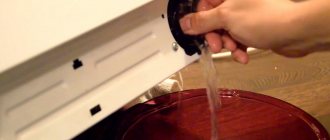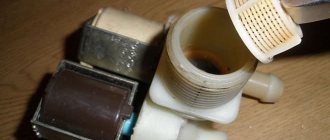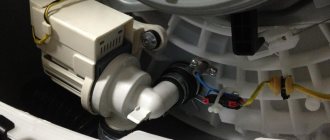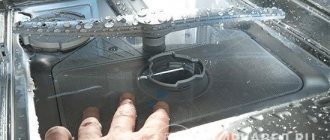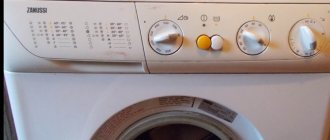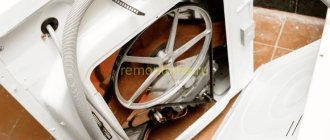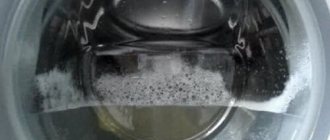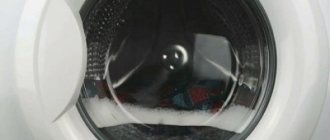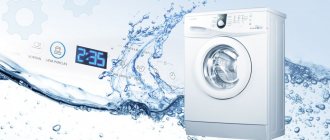The washing machine drain does not work - one of the most common faults.
Manifestations:
- the wash stops at drain, the water does not leave the tank;
- water leaves the tank very slowly and the program crashes;
- there is no water in the tank, but spinning does not occur;
- During washing, the water is drained, but at the end, after rinsing, it is not drained;
- On one wash the water drains, on the other it does not drain.
Causes:
- clogged drain pump filter;
- clogged pipe leading from the tank to the pump;
- a large foreign object enters the pump impeller and jams it, after which the pump cannot rotate;
- clogged drain hose;
- clogged siphon or sewer;
- The drain pump is faulty.
Repair:
Disconnect from the network. Disconnect the washing machine from the power supply!
Pump filter. Check the pump filter for blockages. It is located on the front wall of the washing machine, below, under the small hatch, on the right or left. The washing machine does not drain water if the filter is clogged. You need to unscrew it and clean it.
Before unscrewing the filter, we tilt the machine back and place a container under it to drain the water, unscrew it carefully so that we have time to screw it back when our container is full.
Pump impeller. Check the pump impeller. It is located behind the filter. You need to shine a flashlight into the hole where the filter was unscrewed from and check the impeller itself and around it. Even the entry of a small object (coin, toothpick, hairpin, etc.) can cause the pump to malfunction and the water will not be drained. If you find a foreign object, remove it with your hands or using tweezers.
Clean the drain pipe. If, after removing the filter, the remaining water does not drain from the tank, this means that the pipe connecting the tank to the pump is clogged. Then, for convenience, you need to disconnect the pump from the body of the washing machine, or rather not the pump itself, but the entire drain assembly or pump chamber. This is a plastic part that allows you to connect the pump, drain pipe and drain hose together, as well as secure this entire assembly to the body of the washing machine. The pump chamber is secured with screws, after removing which it is easy to disconnect it from the body and it will be easier to get to the pipe.
You need to act carefully. Disconnect the end of the pipe that is attached to the pump chamber with a powerful clamp and gradually clear the blockage by cleaning the corrugated rubber pipe and gradually draining the water from the tank into the prepared container. Then reconnect the pipe to the pump chamber, exactly the same as it was at the beginning, without changing anything. If, after removing the filter, all the water flows out of the machine, then the drain pipe still needs to be checked for blockages by probing it along its entire length, and if foreign objects are found in it, carry out the cleaning procedure.
Checking the serviceability of the pump. After completing the previous steps, you need to check the serviceability of the drain pump. To do this, connect the washing machine to the power supply and select the “drain” program (if there is none, then “spin”). In this mode, the pump should begin to rotate, which can be observed in the filter hole. You need to shine a flashlight there and understand whether the pump impeller is rotating or not. If it does not rotate, the pump must be replaced.
The first steps to replacing the pump are similar to clearing the blockage from the pipe connecting the tank to the pump, only the pipe itself does not need to be disconnected from the pump chamber. After the machine is tilted back and the pumping chamber is disconnected from its body, it is necessary to disconnect the pump itself from the power supply wires and from the pumping chamber itself. Basically, modern washing machines are equipped with drain pumps of several of the most common types that are usually on sale.
One more subtlety. A situation may arise where the water does not drain, but everything is fine. You removed the filter, checked the pipe and drain hose, but there are no blockages, and you can see that the pump turns when you select the “drain” program. There are two options - either the drain hose is clogged and the hose needs to be cleaned, or the pump has exhausted its service life and only runs dry. That is, it can turn without water, but with water it jams, it does not have enough power. This pump must also be replaced.
Why doesn't the equipment drain the water?
Causes of problems in Ariston:
- Program crash. Perhaps there was a network overvoltage or a power outage, which allowed the Ariston machine to “think” about performing the task at hand, specifically about draining, or to stop working completely. Knocking on the top cover or the presence of heavy objects similarly cause a malfunction, which also stops the drain.
- The drain hose is blocked by foreign objects.
- Clogged sewer system.
- Foreign objects have entered the filter.
- Pump or pump failure.
- Extension of the hose or placement at an unacceptable level.
- Wiring open or shorted.
Some of the problem can be solved yourself, while the machine will remain in working order. The owner of Ariston is lucky if his machine is equipped with the Smart diagnostic function. Using special keys, Wi-Fi and a smartphone, the machine is diagnosed, and after a few seconds a notification is received about the breakdown, the possible cause and how to fix it. This option is factory-installed, but is installed in more modern Ariston models.
Diagnosis and troubleshooting
Program crash
- Restart the program. Press start wash cycle and wait. If there is no reaction, turn off the machine and start draining.
- Remove heavy objects from the lid and try to restart the drain.
- If the problem is not solved, then the problem is not in the program.
Hose
- Check the bend radius. Minimum 50, maximum 80 cm. If it is bent or not bent, then the water simply will not reach the drain. The machine will receive a signal to the built-in sensors, and the command will remain unfulfilled. You can fix the problem using a special clamp that comes with the washing machine.
- Possible squeezing. This happens if you step on or knock over something heavy. The situation will not only stop the cycle, but also break the rubber. Remove any foreign objects.
- Check the connection. The fastenings could come off, and the smart machine decided not to drown the neighbors below.
Sewerage
- Open the tap or flush the toilet tank; if the water does not drain, you need to clean the system.
- When disconnecting the drain source from the corrugation, the washing machine must be turned off.
- Clear the blockage.
Filter
- Turn off the power to the washing machine.
- Place a towel underneath.
- Open the filter protection. It is located at the bottom on the right side (if the car is facing the owner).
- Turn the cap to the right and unscrew it.
- Wait until the water stops flowing.
- Remove the filter and inspect for excess contents: buttons, coins, washing powder.
- Rinse the part. The water should not be hot.
- Rotate the impeller (located behind the filter); if it moves freely and does not jam, then the pump is in order.
water pump
- After draining the water and removing the filter, start the spin cycle.
- If the impeller remains motionless, there may be a problem with the pump or pump.
- When the pump makes an unusual noise, water has most likely leaked into it. In such cases it must be replaced.
- To diagnose, you need to remove the lid of the washing machine.
- You can fix the problem yourself if, after a visual inspection, minor damage is visible.
- Did the examination yield no results? Then contact a specialist who carries out highly qualified repairs of Ariston machines.
Wiring
- Remove the top cover and inspect the wires.
- Perhaps the previous spin helped to disconnect the block of wires from the board. Return the block to its original position and restart Ariston.
- Check for moisture or broken contacts
Drain pump
If the problem is still relevant and the water still does not drain, you will need to move on to the next step. As part of this, we need to check the pump, or rather, find out whether the impeller is jammed . It is located right behind the filter, and if there is even a small object in it (for example, a rivet from clothing), this can cause a breakdown.
In view of the above, at the initial stage you need to try to rotate the impeller. When it spins and there are no foreign objects, it is in good working order. But in the opposite situations, you will need to immediately remove the foreign object. If this does not solve the problem, check the electrical system of the drain pump.
For these purposes, remove the filter, following the instructions presented above. Then set the spin mode and highlight the filter hole. A small flashlight or phone flash will work for this. When the impeller is stationary, this is a clear indication of a pump failure. So, the fault has already been found, and we need to move on to the next step - installing a new component.
But before you replace the drain pump, you will need to buy it. The design of most washing machines includes standard parts, so we can easily purchase one that suits us at the nearest household appliance store or at the construction market. And if the sales points are located at a decent distance from your home, you can go to the World Wide Web and find the necessary components in online stores.
So, the part has been purchased, and it’s time to install it. To do this, dismantle the drain assembly and disconnect the drain pump from it. Then, with special attention, we remove all the wiring from it, take the purchased part and make a replacement. We return all the wiring and other parts to their original position, and then assemble the Hotpoint Ariston washing machine to its original condition.
At this stage, the question: what to do if the drain is not working is completely resolved. And you can easily restore the functionality of the equipment yourself at home using the instructions provided.
Interesting:
- Review of built-in dishwashers Ariston 45 cm
- Review of Ariston top-loading washing machines
- Ariston washing machines
- Reviews of Hotpoint Ariston dishwashers
- Repair of malfunctions of Ariston washing machines
- Reviews of Ariston washing machines - Hotpoint
Reader comments
- Share your opinion - leave a comment
The appearance of a breakdown and its causes
If you start to notice that your washing machine is not draining, you need to pay attention to its behavior. First of all, you need to figure out what manifestations the indicated breakdown has. Among the “symptoms” the following clearly stand out:
- slow draining, with possible software failure;
- after starting, the wash stops when draining;
- several times the water drains, and several times it does not;
- When washing, everything goes in the standard mode, but at the moment of rinsing, the drainage stops;
- Spin is not activated after draining.
What causes the breakdown to occur? The reasons are varied, but in a particular case, the behavior of the washing machine will help determine it. First of all, the equipment may issue an error code indicating the nature of the malfunction.
- The pipe connecting the pump and the tank is clogged.
- The pump is clogged with a small object.
- The garbage filter is clogged.
- The pump has failed.
- The siphon or pipes are clogged.
- The water drain hose is clogged.
Emergency “opening” of the machine
If for some reason you cannot drain the Ariston Hotpoint through a garbage filter and hose, you will have to turn to the “heavy artillery.” The latter means an emergency opening of the hatch door followed by scooping out water. This procedure will require more effort and time, so we proceed to it as a last resort.
- we estimate how much water is in the tank (if the liquid level is above the edge of the drum, then tilt the machine back and fix it);
- open the machine;
- scoop out the water.
A simple sequence is complicated by some nuances. The first is the need to urgently open the door. It will not be possible to open the hatch by pressing the handle, since Ariston is securely blocked during washing. The blocking is bypassed using a rope, which must be inserted into the gap between the door and the body and, directed into the depth, pulled until a characteristic click is heard. Afterwards we unlock the machine in the usual way.
Cleaning the garbage filter
The procedure is carried out in several stages. Even if you have no experience in this matter, you should be able to handle it. Well, if you encounter any problem, you can always call the specialist.
First of all, you will need to turn off the water and disconnect the equipment from the power supply. There is a possibility that you will need to move or lift the machine. And you probably don't want to get electrocuted when the remaining water in the machine leaks onto the floor.
In the second step, you should find where the filter is installed, then open the hatch cover and remove the false panel. As a rule, the hatch is held in place by a latch, which can be pryed off using a flat-head screwdriver. But there are also models where you can open it without additional tools.
Cleaning the drain pipe
According to statistics, most often the drain does not work precisely because of a clogged pipe. You can only get to it through the bottom of the washer. Models with an open bottom are equipped with a pipe that is led out. You just need to put the equipment on its side, and the pipe will become visible. But models that have a tray or bottom cover require their removal, after which access to the pipe will again open. The Ariston washing machine, or rather its connection, has three connection points: a tank, a pump, and a pressure regulation hose.
The first task is to loosen the pipe clamps at each connection point. Afterwards you just need to move it to the side. In situations where the condition of the pipe is satisfactory, cleaning is performed using a special brush. They can carry out a thorough cleaning and then return the part to its original position. But if there is serious wear or serious damage, it will need to be replaced by installing it on the existing fasteners.
Interesting! You can carry out high-quality cleaning of the pipe with a solution of citric acid. To prepare it, you will need to take 2 liters of water, dissolve 100 grams of lemon juice in it, and then place the pipe in the resulting liquid for several hours. Afterwards, the part will need to be removed and washed thoroughly with cold water.
DIY Ariston washing machine repair
If you have the necessary knowledge and experience, you can repair your washing machine yourself. There are many videos on the Internet that describe in detail how to troubleshoot problems.
Important: during the warranty period, it is not recommended to repair the device yourself - this may void the manufacturer’s warranty.
Replacing bearings for an Ariston model with a plastic tank:
- Drill the protruding edges of the seam around the perimeter in several places to bolt the place where the tank will be glued together after repair.
- Use a fine-toothed hacksaw to cut around the perimeter of the tank, strictly following the seam line. Start cutting from the bottom base of the tank.
- Divide the tank into halves. Use a knife to cut off the burrs at the cut site.
- Unscrew the pulley mounting nut.
- Remove the pulley from the shaft.
- Use a rubber or wooden mallet to knock out the shaft with the drum from the inner ring of the bearing in the central hole of the tank. To do this, place bricks around the perimeter of the tank cut and treat the bearing assembly with WD-40.
- Use a screwdriver to remove the bearing seal.
- Use a metal drift to knock out the shaft bearings.
- Clean and rinse the tank halves and drum.
- Use a flat metal drift to push the new bearings into the mounting locations.
- Install the bearing seal.
- Lubricate the oil seal and shaft with grease.
- Install the shaft with the drum, put the pulley on the back of the tank and tighten the nut.
- Degrease the cut edges of both halves with white spirit.
- Using a gun, apply sealant evenly around the perimeter of the cut on both halves and connect them.
- Insert the bolts into the pre-drilled holes and tighten.
- Screw self-tapping screws around the perimeter into the protruding edge of the seam in increments of about 10 cm.
- Allow the sealant to dry overnight.
